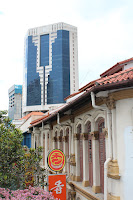We went to Singapore for three days right before our trip to Pulau Bidong. The blog posts are a bit out of order (inspiration doesn't follow chronological order). But here goes.
 |
Welcome to Singapore,
said the Merlion |
The city-state of Singapore is a unique case study of what a people can do when they are unified in thought and process. And in the example of Singapore, it’s to create a society and economy wrapped around human capital and capitalism. In the five decades (give or take a few years) that Singapore has existed as a country, it has become one of the most dynamic and modern nations in the world, vastly outpacing Malaysia (with which it has a shared history) and all of South East Asia. All the while, the island-nation has no natural resources and covers only 268 square miles and with a population of only 5.184 million.
Is Singapore indeed a utopia: a democratic, vibrant, diverse society, with little crime and a great eating culture? Or is it a nation with a federal government that is so deeply ingrained in all aspects of life there, going to what in the US we would consider extreme measures to impose capitalism, civility, cleanliness, and order: the true embodiment of Thomas Hobbes’ Leviathan? Or is Singapore the ultimate rat-race, where people are put under immense pressure to perform at work and school, logging long hours to jump up in the corporate ladder; where people walk fast and even the escalators similarly move at a rapid pace?
To be honest, Singapore is all of that. It’s a small population unified by a single goal--the drive to succeed. This includes all aspects of life. The country seems to be under constant construction—or reconstruction—keeping it modern. But at the same time, there is respect for its history—the old Chinese cantons are kept and updated and the former British colonial buildings are preserved. And this is perhaps the cleanest city I have ever seen.
 |
Blending the old with
the new in Chinatown |
Singaporeans have decided that for this to happen, there has to be a strong government presence involved, imposing its will through regulations. Singapore is often described as a “fine” city. And by that, the city would fine the crap out of you for minor infractions—littering,
simply possessing chewing gum, jaywalking, whatever. And I mean fines in the thousands of dollars. (Oddly, I’ve been told the fine for public nudity is only in the few hundreds—go figure!) And illegal drugs? You’re risking your life there. And all this effort is to keep the city-nation clean, orderly, modern, and safe. Want to gamble at the new
Marina Bay Sands as a Singaporean citizen? Pony up a hundred bucks first. This is the government’s attempt to keep its citizens from getting addicted to gambling.
Being an American, I find this type of morality regulation and excessive government intrusion a bit much, but hey, it works for Singaporeans: the city/country is clean, orderly, wonderfully planned; their subway runs on time; and the economy is strong--which is more than I can say about the US. Who am I to say that they're doing it wrong?
 |
The Marina Bay Sands, an
indulgence in grandiosity |
Is the pace of life in Singapore, then, necessarily fast with an exceedingly strong push to succeed in order to keep this mythos of "Singapore"? With my laid-back California pace, I nearly tripped when getting on the escalator the first time in the MRT station. But perhaps that says more about Californians--and Americans in general--than about Singaporeans. Perhaps we've lost our drive, become too comfy, forgotten what it takes to excel because we've lived the good-life for too long, and our economy is struggling to recover as a consequence.
Something to ponder as we struggle to maintain our roads and highways and bleed manufacturing jobs out of our noses.